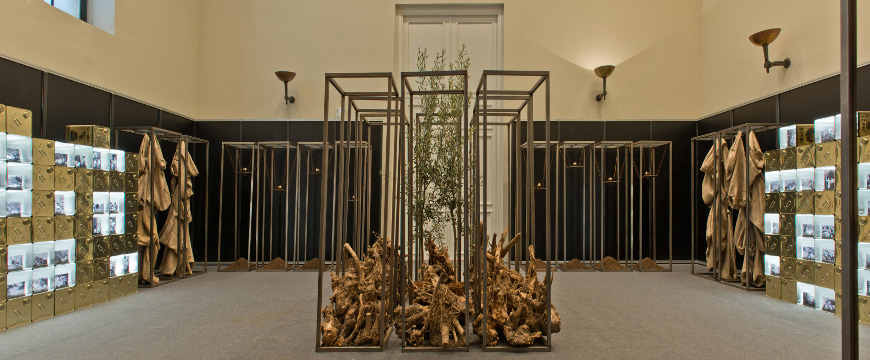To create a unique, inspiring atmosphere in Delphi where judges from 11 countries evaluated 359 olive oils for the Athena International Olive Oil Competition, competition chairman Constantine Stergides hired architect Elena Stavropoulou to make a striking art installation. Her installation memorialized the Greek olive oil production tradition of the past.
This was a tradition of harvesting by hitting olive branches with sticks, gathering olives from the ground in woven baskets, and transporting olives in burlap bags to old stone mills for pressing. Many families still gather to work together during the olive harvest, like those pictured in black and white photos in the installation from as far back as the 1950s and ‘60s. And olive oil remains central in many Greek Orthodox Church ceremonies, as symbolized by the olive oil lamps in the installation.
On the other hand, parts of the tradition are being supplanted by the use of mechanized harvesters, transport in specially designed crates that better protect olives, and extraction of oil in modern stainless steel machines. The 17 kilogram tins and bulk production for export are gradually yielding to increased percentages of carefully produced, exquisitely bottled, high quality award winning Greek extra virgin olive oils like those recognized by the Athena International Olive Oil Competition and other competitions in Greece and worldwide.
Stavropoulou told Greek Liquid Gold she considers her installation “a memorial” to the traditional olive oil production phase that is ending as we enter “a new era of bottled olive oil. The old way should end now; we do not bury the past, and we do not consider it of merely minor importance, so we memorialize it.” In the text that follows, Stavropoulou explains the philosophy and vision behind her installation.
--Lisa Radinovsky
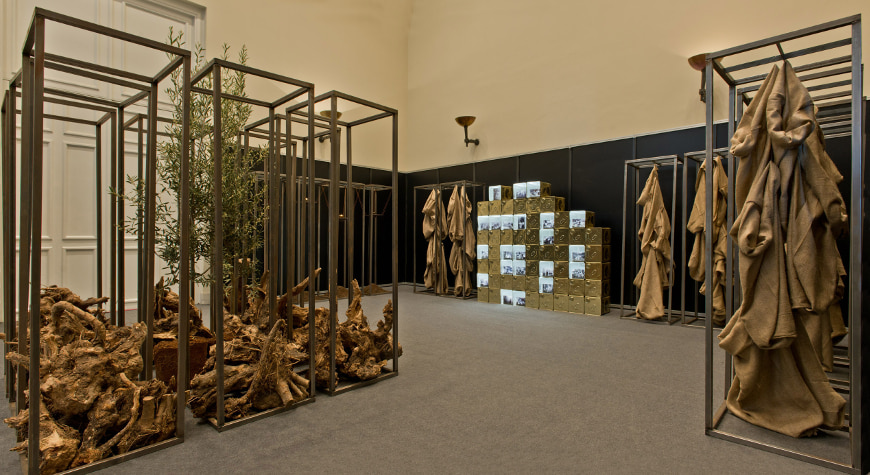
Constructing the Commons: Olive/Oil/Light
The architectural practice Stavropoulou Architects undertook the design of the space in which the Athena International Olive Oil Competition judging took place in the European Cultural Center of Delphi. For this purpose, Elena Stavropoulou created an installation focused on the theme Constructing the Commons: Olive | Oil | Light which she reproduced in the Zappeion Conference and Exhibition Center for the Athena Competition’s tasting day and awards ceremony. The installation aims to reveal the diachronic economic and cultural significance of olive oil as an occupation, with its gaze fixed on its new era.
The Commons are goods that have been inherited from previous generations, have been created collectively, or are a natural heritage. Olive oil is inscribed in a material and symbolic way in the tradition of the Mediterranean. The land, the olive, oil, its production in the factory, its standardization and enjoyment, are also part of the discussion about the Commons.
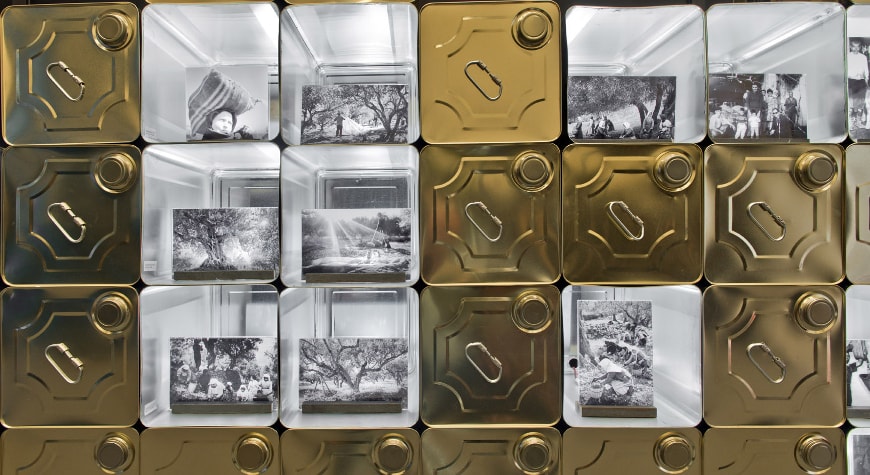
These daily practices related to olive oil (its production and uses) regulate societies and construct the intermediate time, the before and after the gathering of the olive. They define the way in which local communities are formed, the way in which they create thresholds of sharing, participating in the construction of the imaginary: the seasons, the harvest, life in the mill and the economy around it, the dinner table, light.
The installation tells, in space, the story of the olive oil cycle: from the tangible soil to the intangible light of the lamp. From the compact, irregular root to the standardized package.Τhe installation deals with olive oil as a material product and as a symbol, rooted in culture and tradition, as well as in wellbeing and care in the contemporary metropolis.
The trajectory of olive oil is developed in the exhibition space as a diptych: the growth of the fruit, and then the harvest and its use. Calling upon memory to activate common stories from the origins, it reinscribes stories and images in the present, using the most "humble" materials: the soil, the root, cloth, sacks, the tin, the lamp.
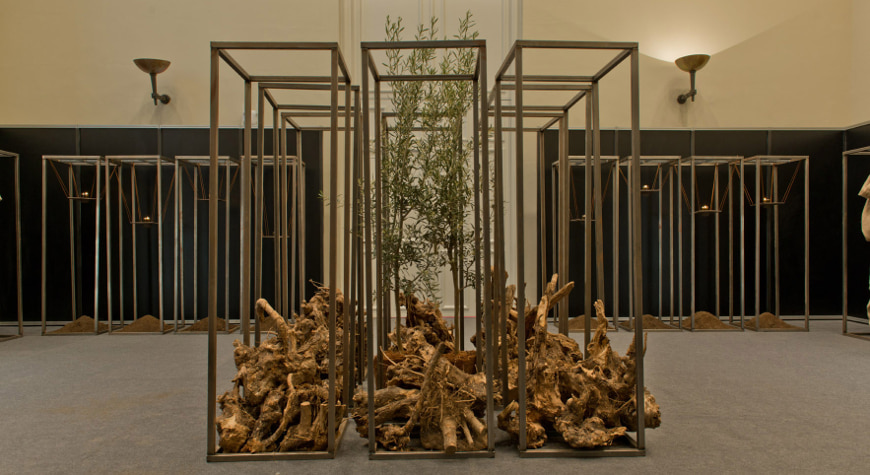
Soil - Roots - Fruit
The exhibition narrative begins with the soil which receives and nourishes the plant, where the olive tree spreads its root, irregularly and magically. In order to invite – at a second stage - people to take care of it, and to gather its fruits.
Sacks – Tins – Lanterns
The olive net is stretched. The harvest starts. The fruit is collected; mastery, cooperation, and labor are required.
The sacks are waiting. They are stuffed and transported. Agony about the crop.
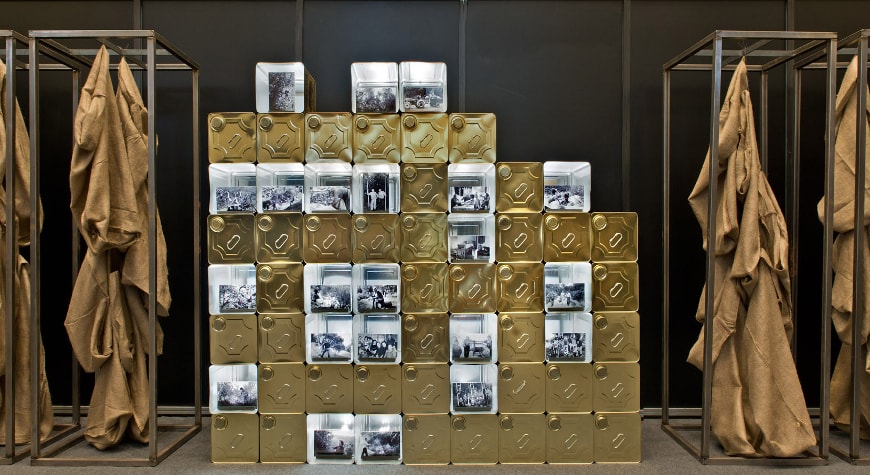
The tin will travel. Full of the year's labor, it carries memories: the work, the misfortunes of weather, olive growers’ expectations and engagement in their task. The tin functions as a memoir. In the installation, the tins are opened; they become light-filled shells, where photographic snapshots of the life determined by olive gathering are positioned, enhancing the memory game.
The ceramic lamps - handmade by the architect herself with clay, a raw material so relevant to the soil – welcome the oil, in order to transform it into light. Just as the soil makes the tree from the seed. The lamps, with their curved lines, refer to the maternal figure, to mother earth, who welcomes, cares, nourishes.
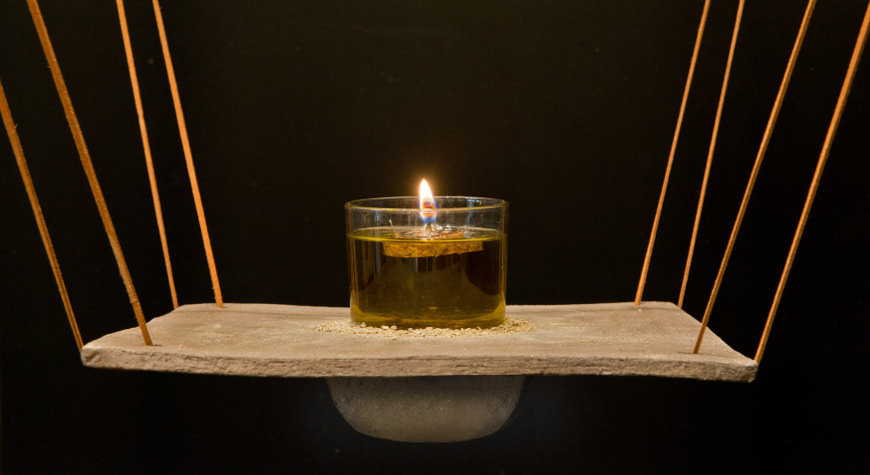
Oil is a gift, often offered in a tin or in a bottle, contributing to acts of caring: the care of the land, of the field, of the olive grove, of the oil. Caring about humanity, nutrition, life. It heats, nourishes, gives light to the lamp, creates atmospheres, plays with visibility, illuminates paths.
The cycle of nature and production shapes the rituals of the new era. From the soil to the light. The circle closes. Until its re-enactment.
--Elena Stavropoulou
________________________
Thanks to Stavropoulou Architects for the photos by Kostas Thomopoulos. The photos within the installation are courtesy of photographers Katerina Kalogeraki and Manolis Tsantakis, and the archives of Elaiotriveio Kyklopas, Elaiotriveio Kallas, and E.l.i.a.


